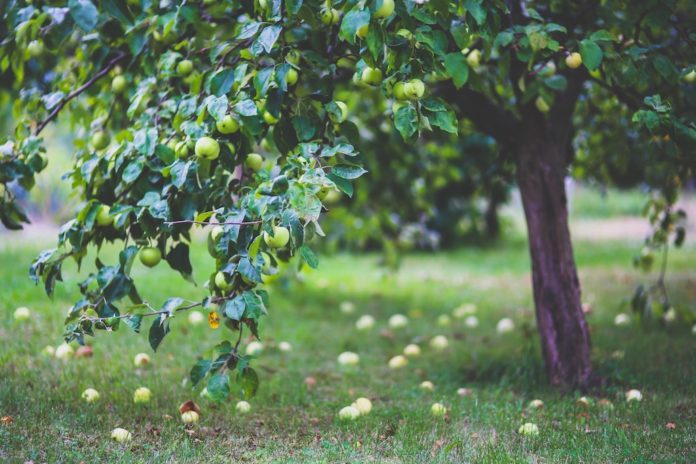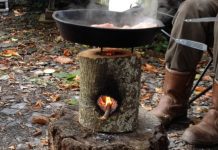Many homesteaders and preppers want to start their own home orchard as a means of increasing their food self-sufficiency. Fruit trees provide a perennial, low maintenance, and long-lasting food source. Plus growing your own fruit can save you a lot of money. You can enjoy fruit fresh or freeze, dehydrate, or can it for the winter months.
While many people picture fruit trees on large farms or orchards, it’s still possible to grow your own fruit even if you live on a small farm or homestead. The most common fruit trees to grow in the U.S. include:
- apples
- nectarines
- pears
- plums
- sweet cherries
- sour or pie cherries
- peaches
- oranges
- lemons
Step #1: Choosing Trees
To begin you’ll need to select a fruit tree. Beyond just selecting your favorite fruit there’s a few points to consider. First you need to find a tree suitable to your local climate. If you’re buying from a local nursery you’re all set. However, if you plan to order non-local trees you’ll need to know your USDA hardiness zone. This will allow you to narrow down varieties that are heat or cold hardy enough for your specific region. You may also want to take a variety’s water needs into account if you live in a particularly dry area.
If space and funds are limited you may also want to think about how to get the most food from your space on your budget. Certain fruit trees are more prolific, some produce in less time, and others live longer. There’s also dwarf, semi-dwarf, and standard fruit trees available to fit your homestead’s specific needs. It is worth noting that the smaller trees tend to produce more quickly but live shorter lives than the larger trees. If you plan to live on your property a long time you may eventually need to replace smaller trees.
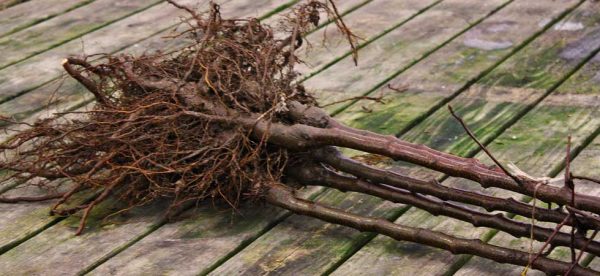

Standard size trees can often grow up to 30 feet tall or more, so they can also be utilized as shade trees on your landscape. Upon maturity, they will offer the largest harvests, but they can be more difficult to prune and maintain as well as to harvest from.
Many nurseries, especially those that ship trees, sell their trees bare root. Bare root trees are just like they sound. They’ll come with no soil around their roots and this is totally fine! They’re just dormant and will begin growing again once re-planted. You can also expect these trees to come with few branches but your tree will start filling out the first summer so there’s no need to worry.
Related: 10 Trees Every Survivalist Should Know and Why
Step #2: Selecting the Site
Once you’ve chosen trees you’ll need to decide where to plant them. Fruit trees prefer full sun so it’s best to find or clear an area that receives as much sunlight as possible. If this is a problem on your property you may want to consider a sour cherry tree. They produce better with some shade than most other varieties.
If you have it available the ideal place for fruit trees is near the top of a north facing slope. Facing the north gives the trees less spring sunlight and warmth which can encourage them to bloom later and avoid damaging spring frosts. The slope shouldn’t be too steep but a slight slope helps with drainage and discourages root problems.
If you have the time you may want to visit your site several times throughout the year before planting to watch for erosion, high winds which could damage tree limbs or even topple young trees, and monitor seasonal sunlight.
You should also examine and test your soil. Fruit trees do best in well drained soils. Very sandy soils may drain too well and not provide your tree with enough water while heavy clay soils can hold too much moisture causing various root rots. However, any soil can be amended and methods will be discussed in the “Soil Preparation” section.
Step #3: Tree Spacing
After you have an idea about where you’d like to plant you’ll need to consider the space your tree or trees are going to need. Different size and type trees will obviously have different heights as well as root and crown sizes. Consider this carefully if you’re planting anywhere that isn’t completely open.
Many people forget about how the roots can spread and affect things underground like wires and piping. When you purchase your tree it should come with information about its size at maturity but the list below will give you a general idea for several fruits in dwarf and standard sizes.
Related: Trees That Can Be Tapped For Sap And Syrup
Fruit Tree Space Requirements
Apple
Standard: 35’ x 35’
Dwarf: 10’ x 10’
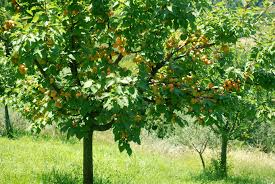

Apricot
Standard: 20’ x 20’
Dwarf: 10’ x 10’
Peach
Standard: 20’ x 20’
Dwarf: 10’ 10’
Pear
Standard: 20’ x 20’
Dwarf: 12’ x 12’
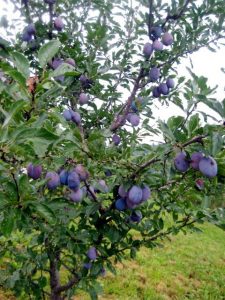

Plum
Standard: 20’ x 20’
Dwarf: 10’ x 10’
Sweet Cherry
Standard: 20’ x 25’
Dwarf: 10’ x 10’
Sour (Pie) Cherry
Standard: 20’ x 20’
Dwarf: 10’ x 10’
You should also take into consideration how you intend to prune your tree which will affect its roots along with height and crown size. For some with limited space espaliering or training and pruning a tree to grow flat up against a fence or building may be a great option. Espalier trees can also gain residual warmth and wind protection from the structure behind them.
Step #4: Preparation
The best times to plant fruit trees is when they’re dormant during the early spring or fall. If you live in a northern area where the ground freezes fairly early in the fall it’s best to spring plant your trees. This ensures the roots have plenty of time to get established before the ground freezes which can damage or kill young roots.
Once you’ve tested your soil you can amend it if it has any deficiencies. Fruit trees generally prefer soil that is high in calcium, magnesium, and potassium but not too high in nitrogen, phosphorus, and other micronutrients.
It’s best to avoid adding commercial fertilizer as this can add too much nitrogen to the soil. Excessive nitrogen can make the tree grow too fast and potentially have a crown too big for its root system to support and make it more susceptible to certain diseases. For specific advice on your soil test and fruit tree variety contact your local agricultural extension agency.
In place of commercial fertilizers it’s safe to add plenty of compost to your site. Compost not only add nutrients but helps with soil structure so it’s especially important to add if your soil is a sandy or heavy clay soil.
No matter what size tree you’re planting, you should plan on digging a larger hole than needed and filling it back in around the tree with soil and about 50% good quality compost. This helps ensure that the tree has adequate nutrients and drainage and makes it easier for the roots to grow through the soil. If your soil is particularly poor, you may choose to amend the soil in the entire area the roots will reach at maturity. You can estimate this by finding out how wide your tree’s crown is expected to grow.
In this process you should also remove any weeds and any existing perennials from the area as they can compete with vulnerable new transplants.
Related: How to Make Apple Cider Vinegar
Step #5: Planting
You want to plant your tree at the same depth as it was previously growing which should be fairly easy to determine while you’re looking at your tree whether it’s bare root or not. If you’re planting a bare root tree it’s best to soak it in water for about 8 hours prior to planting it.
After planting, you should thoroughly water your fruit tree. To give it an added boost, you may want to water it with compost or manure tea which will give it easily accessible nutrients.
Depending on wildlife in your area, you may need to place fencing around your tree to prevent herbivores from damaging the young tree. They also sell a tree wrap that expands as the tree grows and will keep small herbivores like mice and rabbits from eating the bark during winter.
Once the tree is planted, you’ll want to cover the exposed soil to block weeds, prevent erosion, and stop moisture loss. You can do this by using mulch such as old straw or leaves or planting a cover crop. If you decide to mulch around your tree do not make the mistake of mounding it up around the tree’s trunk. This will give rodents a place to hide as they gnaw on your tree. It can also attract insects that may attract the tree. If you go with a cover crop use an annual crop like buckwheat that will winter kill. It won’t compete with your tree and after it dies it will become mulch.
As the mulch or leftover cover crop rots down, it will add more nutrients and structure to the soil around your tree just like leaves on the forest floor do in a natural setting. You should keep this process up at least until your tree is well established.
That’s really all there is planting a fruit tree! As long as you maintain it with watering and pruning as well as monitor it for disease and pest issues you’re well on your way to having a sustainable and delicious food source right in your backyard.
Related: 18 Plants That Should Always Be Planted Together
How to Plant Your New Fruit Tree:
How to Plant a Potted Tree:
How to Plant an Apple Tree:
Plant a Cherry Tree:
While there’s nothing about homesteading or prepping that’s easy, adding fruit trees and other perennials to your property can bring a lot of food with relatively little effort. Following this guide you can choose great trees and provide them with a great start to reap a bountiful harvest. What type of tree are you adding to your homestead?



